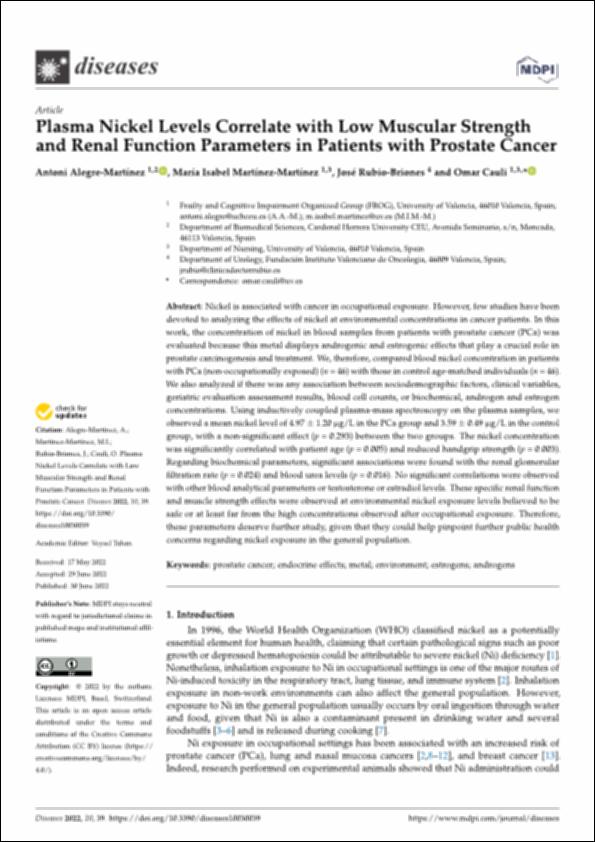Please use this identifier to cite or link to this item:
http://hdl.handle.net/10637/14300Plasma nickel levels correlate with low muscular strength and renal function parameters in patients with prostate cancer
| Title: | Plasma nickel levels correlate with low muscular strength and renal function parameters in patients with prostate cancer |
| Authors : | Alegre Martínez, Antoni Martínez Martínez, María Isabel Rubio Briones, José Cauli, Omar |
| Keywords: | Estrogen.; Andrógenos.; Androgens.; Próstata - Cáncer - Aspectos endocrinológicos.; Niquel.; Nickel.; Prostate - Cancer - Endocrine aspects.; Estrógenos. |
| Publisher: | MDPI |
| Citation: | Alegre-Martínez, A., Martínez-Martínez, M. I., Rubio-Briones, J. & Cauli, O. (2022). Plasma nickel levels correlate with low muscular strength and renal function parameters in patients with prostate cancer. Diseases, vol. 10, i. 3 (30 jun.), art. 39. DOI: https://doi.org/10.3390/diseases10030039 |
| Abstract: | Nickel is associated with cancer in occupational exposure. However, few studies have been devoted to analyzing the effects of nickel at environmental concentrations in cancer patients. In this work, the concentration of nickel in blood samples from patients with prostate cancer (PCa) was evaluated because this metal displays androgenic and estrogenic effects that play a crucial role in prostate carcinogenesis and treatment. We, therefore, compared blood nickel concentration in patients with PCa (non-occupationally exposed) (n = 46) with those in control age-matched individuals (n = 46). We also analyzed if there was any association between sociodemographic factors, clinical variables, geriatric evaluation assessment results, blood cell counts, or biochemical, androgen and estrogen concentrations. Using inductively coupled plasma-mass spectroscopy on the plasma samples, we observed a mean nickel level of 4.97 1.20 g/L in the PCa group and 3.59 0.49 g/L in the control group, with a non-significant effect (p = 0.293) between the two groups. The nickel concentration was significantly correlated with patient age (p = 0.005) and reduced handgrip strength (p = 0.003). Regarding biochemical parameters, significant associations were found with the renal glomerular filtration rate (p = 0.024) and blood urea levels (p = 0.016). No significant correlations were observed with other blood analytical parameters or testosterone or estradiol levels. These specific renal function and muscle strength effects were observed at environmental nickel exposure levels believed to be safe or at least far from the high concentrations observed after occupational exposure. Therefore, these parameters deserve further study, given that they could help pinpoint further public health concerns regarding nickel exposure in the general population. |
| Description: | Este artículo se encuentra disponible en la siguiente URL: https://www.mdpi.com/2079-9721/10/3/39 Este artículo pertenece al número especial "Inflammation in Neuro-Psychiatric Disorders: A Themed Issue to Celebrate MDPI's 25th Anniversary". |
| URI: | http://hdl.handle.net/10637/14300 |
| Rights : | http://creativecommons.org/licenses/by/4.0/deed.es |
| ISSN: | 2079-9721 (Electrónico) |
| Language: | es |
| Issue Date: | 30-Jun-2022 |
| Center : | Universidad Cardenal Herrera-CEU |
| Appears in Collections: | Dpto. Ciencias Biomédicas |
Items in DSpace are protected by copyright, with all rights reserved, unless otherwise indicated.


